We often see posts from people on forums who are worried that their fancy goldfish has ‘swimbladder’. The word seems to have become a generic term to describe/diagnose buoyancy problems experienced by fancy goldfish. Fancy goldfish do tend to be prone to buoyancy problems but these are not always caused by true ‘swimbladder disease’. The cure is often a lot simpler than you might be expecting, and sometimes a few simple changes can quickly resolve things.
If you have any questions, or would like advice specific to your fish, please consider joining one of our recommended forums where there are experienced fishkeepers who will be able to help you.
“My goldfish has swimbladder disease … or does it …?”
“My goldfish is swimming upside down, does it have swimbladder disease?”
“My goldfish is floating, does it have swimbladder disease?”
If you keep fancy goldfish then the chances are that at some point in your fish’s life you may be asking these questions. If a fancy goldfish is having problems with buoyancy and/or swimming then ‘swimbladder disease’ is the conclusion that many people come to. Unfortunately a little knowledge can be a dangerous thing and sometimes ‘swimbladder disease’ is stated as being the problem without anyone looking at the bigger picture.
There are numerous medications and treatments available which are sold to treat ‘swimbladder disease’. If you go into a fish shop and ask for advice on a floating fancy goldfish there is a strong possibility that they will sell you one of these products. This is not unreasonable; the fish is floating, the treatment says it will stop this. Unfortunately the chances are that the treatment will not stop your fish from floating because it is attempting to treat a condition that the fish does not have.
You need to consider the bigger picture before you can pin down the reason for your fish’s swimming problems. This article is written from personal experience of my own fish and the numerous threads and posts on various forums where I’ve shared and gathered information, and discussed the issue with other fishkeepers. I do not claim to be a scientist or expert in the whys and wherefores of this subject but I hope that this article can help other people improve the lives of their fancy goldfish.
Let’s start from the beginning and go through things step by step …
What is a fancy goldfish?
All goldfish are the same species, they are carp; Carassius auratus to give them their Latin or scientific name. There is sometimes confusion over whether or not a goldfish is a ‘fancy’ goldfish. Broadly speaking there are two types of goldfish:
The singletail goldfish: These fish have a single tail fin (caudal fin). This includes commons, comets and shubunkins. There is sometimes confusion over whether a snazzy looking singletail is a fancy goldfish. The fins can be as long, flowing and fancy as anything and it can be any colour; if the fish has one tail fin it is a singletail goldfish. The body shape of singletails is longer, less compact and more streamlined than a fancy goldfish and they are usually fast, efficient and nimble swimmers. They rarely suffer from buoyancy problems although it is not unheard of.
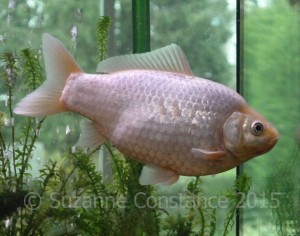
The fancy goldfish: These fish have a double tail fin; this includes fantails, veiltails, ranchus, lionheads, moors/telescope-eyes/dragon-eyes, pearlscales, orandas, bubble-eyes and celestials to name the ones most commonly available in UK shops. There are others but that would be a whole other article in itself! These fish tend to have much more rounded, chubby, compact body shapes. It is these ‘fancy’ goldfish that are more prone to buoyancy problems. There can be confusion between the different types and there are plenty of ‘Heinz 57’ types so don’t worry if you can’t pin your fancy goldfish down to a specific. If it has a double tail fin it is a fancy goldfish.
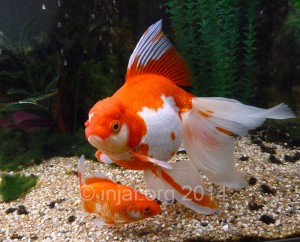
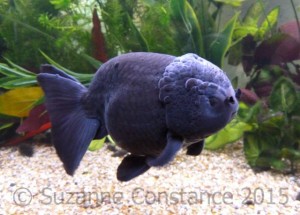
What is a swimbladder?
The swimbladder is an internal organ that the fish uses to maintain its position in the water. It uses it to rise up, dive down or just to sit where it is. In fancy goldfish it is like two balloons joined in the middle which sit underneath the spine towards the rear of the fish. These are called the caudal lobe and the cranial lobe. The caudal lobe is closest to the tail, and the cranial lobe is closest to the head. The swimbladder is filled with air and the fish can regulate the amount of air in the swimbladder to enable it to maintain buoyancy.
What do we mean when we talk about ‘swimbladder disease’?
True ‘swimbladder disease’ refers to an infection of the swimbladder which usually requires medication to deal with. The term ‘swimbladder disease’ or just ‘swimbladder’ is also frequently used to refer to any form of buoyancy problem experienced by a fish. It is this generic, and often inaccurate use of the term which frequently causes confusion, misdiagnosis and inappropriate treatment.
A more appropriate term would be ‘buoyancy problems’.
What causes ‘swimbladder disease’ or ‘buoyancy problems?
There are many causes of buoyancy problems in fancy goldfish. The main causes are generally:
- Poor water quality
- A dietary problem
- Stunting
- A physical problem: the swimbladder organ has not developed properly for some reason
- A deformed or compacted organ due to the nature of fancy goldfish body shapes
- A bacterial infection: the fish has picked up a bacterial infection in its swimbladder which is causing it to malfunction – this is what most ‘swimbladder disease’ treatments are aimed at
- A parasite infestation
- Sudden drops in water temperature following a water change
- A combination of one or more of the above
Does it have actually have a buoyancy problem or is it just a ‘bad driver’?
A round, chubby, compact body shape is not a great design for a fish at the best of times. Imagine a shark, one of nature’s most capable swimmers. A long, torpedo shaped body, able to manoeuvre easily and quickly. Now imagine a shark which is almost spherical, a giant ball with fins and teeth. This shark will not be able to move easily through the water, it will wallow about and find it hard to manoeuvre. This is the fate of the fancy goldfish. Add to that the long flowing fins and you might as well be trying to swim while wearing a wedding dress.
So, they are not great swimmers anyway. A little wallowing and clumsiness is normal. It is not unusual for a fish with a very large, flowing and heavy tail to end up upside-down for a moment as the tail pulls it off balance or it ‘falls over’ while rootling about on the gravel for food. There are also reports of fish with excessively heavy headgrowths (‘wen’) being pulled off balance by the weight of the growth. Some fancies appear to huff and puff a lot and swim backwards with a great deal of flapping about. This is fairly normal for a fish that cannot steer well and often gets itself into places where the only course of action is to reverse. Some fancies will swim upside down briefly if their manoeuvring goes a bit wrong. If they can right themselves and carry on swimming normally once they’ve cornered, or come up from a dive or such like then they don’t have a buoyancy problem.
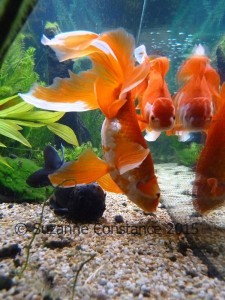
Do not confuse a general inefficiency at swimming with a genuine buoyancy problem.
Goldfish often swim about at the top of the water looking for leftovers, this is not to be confused with floating at the top. Some mouth at the top of the water, again, they are more than likely looking for leftovers. If your fish seems to be gasping at the top of the water or spends the majority of its time mouthing at the top of the water but can otherwise swim perfectly well this could indicate another problem, but not a buoyancy one.
Your fancy goldfish might have buoyancy problems if:
- The fish sits on the bottom of the tank the right way up and struggles to rise up in the water
- The fish lies on the bottom of the tank upside-down and struggles to right itself or swim about
- The fish floats at the top of the tank the right way up and struggles to swim down
- The fish floats upside-down at the top of the tank and struggles to right itself or swim down
- The fish floats about upside-down in mid-water and struggles to right itself or swim about
- The fish swims with its rear end higher than its head or completely vertical
- The fish sits with its nose on the bottom of the tank and its rear end pointing up
- The fish lists to one side, or lies on its side, and cannot right itself or swim about
What do I do if my fancy goldfish has buoyancy problems?
Check the water conditions
The first thing to do is test the water for ammonia, nitrite and nitrate at the very least, and ideally for GH (general hardness), KH (carbonate hardness) and pH (potential of hydrogen, a measure of acidity) as well. Poor water quality can often cause buoyancy problems and this should be the first thing to fix before trying anything else.
If ammonia and/or nitrite show a reading other than zero do a partial water change to dilute the problem and then attempt to track down the cause of the ammonia/nitrite. The following article from fishkeeping.co.uk will help you:
Emergency measures to deal with ammonia and nitrite spikes in a stocked aquarium
There are various products available, such as Seachem Prime, which can be used in an emergency to detoxify ammonia and make the water safe for the fish while you sort out the cause of the problem.
If nitrate reads greater than 40ppm do a partial water change to dilute it. You should aim to keep nitrate below 20ppm. You should also test the nitrate in your tap water to see how much difference a water change will make. You may need to do several partial water changes over the course of a few days to bring the nitrate down to acceptable levels. You can use our nitrate water change calculator to work this out:
Aquarium calculators
Nitrate above 40ppm has been known to cause buoyancy problems. If affects the way the blood vessels dilate which affects the functioning of the swimbladder (I am also led to believe that it affects the digestive system and gill function which can cause gas in the guts and thus unbalance the fish as the guts build up more gas than the swimbladder can counter balance).
If your tap water has high nitrate you may need to take further action to reduce the nitrate in the tank, please have a read of the following article from fishkeeping.co.uk for more information:
Nitrates in the aquarium
Check the temperature of the water. Fancy goldfish do best in temperatures between 20-24 degrees celsius. If the water is too cold consider adding a heater to keep it slightly warmer. Goldfish are not true coldwater fish, they are a temperate species and while they can tolerate cold water, fancy goldfish do better in slightly warmer water. The temperature range suggested above helps keep their metabolism running nicely and helps their digestive and other systems operate optimally.
It’s important to match the temperature of the new water you are putting in when doing a water change to that of the water currently in the tank. Dropping the water temperature too much can cause buoyancy problems, and potentially irreversible ones if the swimbladder suddenly expands or contracts too quickly as the air pressure inside is affected by the change in temperature. You can use our water changes and temperature calculator to help you:
Aquarium calculators
Rectifying any problems with water quality can often be enough to get your fancy goldfish back on the right track.
Check the diet
The food you feed your fancy goldfish can have a significant impact on its buoyancy, and a simple change of diet can often be enough to get your fancy goldfish on the road to recovery and swimming properly again. To understand where the intestines are, if you look at your goldfish and draw a line from its pelvic fins to its vent, the guts are roughly in the area underneath the line.
How does diet affect buoyancy in fancy goldfish?
There are various ways that the diet you give your fancy goldfish can affect its buoyancy.
A lack of fibre can cause constipation; a blockage in the intestines can result in a build up of gas as the food starts to decompose inside the fish. Gas in the guts can cause the fish to lose balance as the swimbladder fails to compensate for the additional buoyancy caused by the gas. The guts being underneath the fish mean that any digestive issues can easily flip the fish over. A blockage can also put pressure on the swimbladder organ and impair its ability to expand and contract properly.
Sometimes a fancy goldfish can be intolerant of certain foods; irritated guts can become inflamed and the fish may produce excessive gas.
Flake food can often be a serious problem for fancy goldfish; many just don’t seem able to tolerate it. Floating food of any sort is best avoided as this reduces the risk of a fancy goldfish taking in excessive air while eating from the surface of the water.
Too much food eaten in a short space of time (and they will, they’re hoovers!) can sometimes result in a blockage if the fish has stuffed in too much at once.
Dry foods should be soaked for a minute or two before feeding otherwise they may swell up once the fish has eaten them and this could cause bloating and may squash the swimbladder a little.
How to rectify dietary and digestive buoyancy problems
If you suspect your fish’s problem may be dietary related, stop feeding for two days then offer a small amount of defrosted, shelled and chopped peas. Peas are a fishy laxative and should help move any sluggish digestive systems. Daphnia and bloodworm fed as live food can sometimes help, although most of us are more likely to have frozen peas to hand immediately!
If this helps, you can start to feed lightly again and monitor how the fish reacts to certain foods. Keep a note of what you give the fish and how it reacts to it. That will help you see if there are any patterns which can be linked to what it’s eating.
Some fish may end up on a almost completely vegetarian diet, so do be sure to vary the veg you give them. ‘Vegetarian’ fancy goldfish will need to eat more than fish who are able to eat a varied diet as they won’t get quite so many nutrients from their food unless you up the rations slightly. Bloodworm is a good food for goldfish, however one of my own couldn’t even look at it without going belly up. Bear in mind that each fish is different, and find a diet that suits that fish.
Keeping the water slightly warmer, towards the upper end of the recommended range, can also help as warmer temperatures can speed up the metabolism and help the digestive system work.
Bear in mind that buoyancy problems caused by diet can take a while to sort out, don’t expect an overnight recovery from being fed peas. Patience is often needed while the fish’s innards sort themselves out and calm down from any inflammation.
Please see our article on goldfish diet for more information:
Goldfish and their diet
Other symptoms to check for
As well as checking for, and rectifying, any water quality problems you need to check for other symptoms as your fish may need treatment of some sort:
- Does it have any red streaks or prominent veins in fins/tail?
- Does it have any red patches on the body (other than normal colouration)?
- If you look at it from the top do its scales stick out like a pinecone?
- Are its eyes protruding more than usual?
- Does it keep its fins clamped against its body?
- Does it try to scratch itself on ornaments or gravel?
- Does it fling itself sideways at the gravel and try to scratch its sides or gills on the gravel (flashing)? Bear in mind that fancies find this tricky at the best of times!
- Is it standing on its head, vertical in the water?
- Does it seem to be breathing heavily while sitting still?
- Check the poo – healthy poo is food coloured and you shouldn’t see excessive amounts of it if your fish’s diet is nicely balanced. If the poo is white, translucent or stringy this is not healthy poo
- Does it have bubbles in the poo? Bubbles can be present in healthy colour or unhealthy colour poo
If it shows some or all of 1-5, 9, 10 or 11 it is possible its buoyancy problems are due to a bacterial infection.
If it shows some or all of 5-11 it is possible it has a parasite problem.
Poor water quality can also cause the above symptoms hence it’s important to check that first and take immediate remedial action if there is a problem with water quality.
Bear in mind that the symptoms shown above could be causing problems in addition to any being caused by dietary issues. It is always wise to err on the side of caution and double check any of the above symptoms as your fish may need urgent medical attention as well as a change of diet. Bacterial infections and parasites need to be dealt with as a matter of urgency; changes to diet can come later.
If your fish needs medication there are plenty of over the counter medications available that should be able to help. It’s always wise to check with an experienced fishkeeper and get another opinion before medicating though.
Spawning
Spawning in fancy goldfish can be quite boisterous and rough; the females get shoved around and quite battered during spawning. They can also be exhausted from being chased around so much. If your female fancy goldfish is struggling with buoyancy, check for signs of spawning behaviour. Goldfish tend to spawn early in the morning, but she may be chased around at any time. If she has missing scales from her sides or has the colour scraped off her sides when you see her in the morning, it’s likely there has been romance before you got up!
Separating her from the boys will give her some respite and allow her to compose herself and rest up a bit. Sometimes this is all she needs to get her buoyancy back on track. She may need permanently separating if the boys don’t relent. In this case you can either move her to a girls only tank, or consider a mesh divider to separate your main tank if there is enough space to allow the fish to still have plenty of swimming room.
Is your fancy goldfish stunted?
Now, be honest here, is it? Stunting can be caused by a variety of issues, please see our article on stunting for more information:
Do fish grow to the size of their tank?
The following chart shows a rough idea of the size a healthy goldfish should be at various ages, although we think the author may actually have been a little conservative on the adult sizes and would advise adding at least another 2 inches (5cm) to both. You can download it from fishkeeping.co.uk.
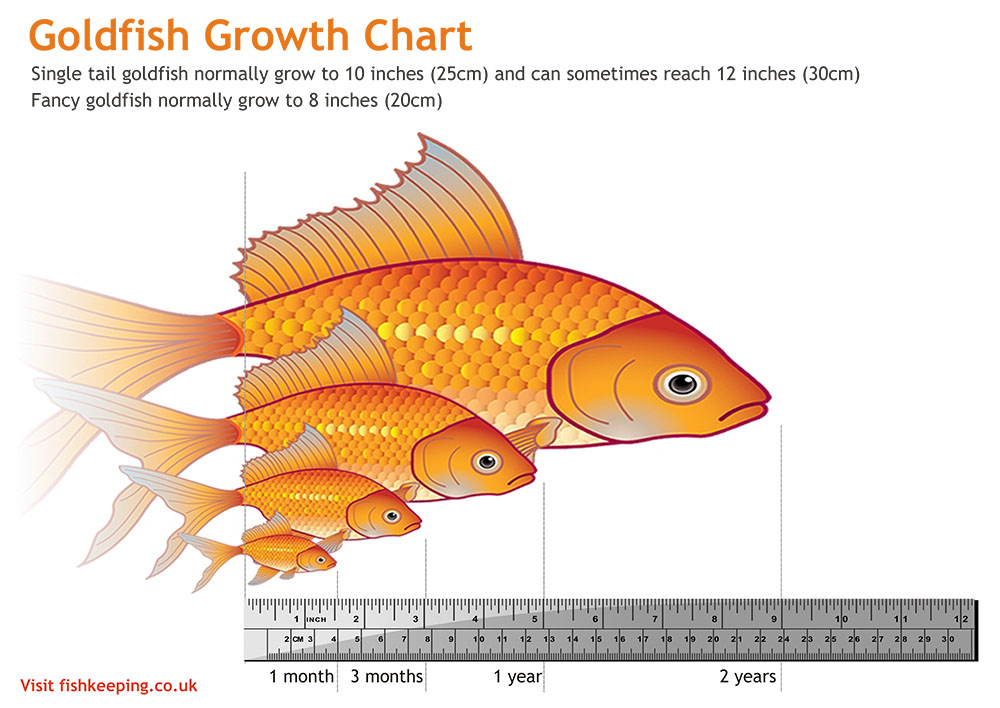
If your fancy goldfish is stunted it’s possible that the swimbladder hasn’t developed properly, or has become squashed as the body fails to develop into the right proportions. Providing your fish with the right conditions can, in some cases, help the fish to recover and regain some buoyancy. Goldfish can grow throughout their lives and will start to grow again once provided with suitable conditions. It’s possible that in some cases they may be able to grow out of any buoyancy problems.
The fish shown below was called Jerry. He was a comet goldfish and as such should not really have experienced buoyancy problems. Unfortunately Jerry was seriously stunted due to inadequate care; this had an effect on his buoyancy. He had to eat little and often otherwise he flipped over as his digestive system wasn’t able to cope with normal amounts of food without squashing his swimbladder.
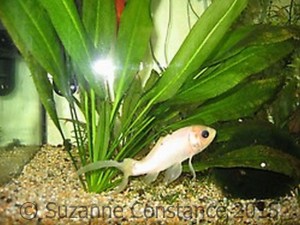
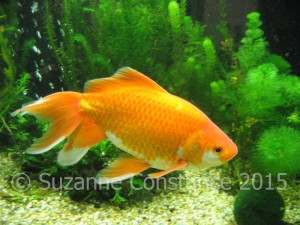
If you discover you have not been providing your fancy goldfish with appropriate care and/or conditions you should take every possible step to remedy this.
Poor quality breeding
Sadly not all fancy goldfish are well bred. Mass production has taken its toll on quality and some fancy goldfish are being produced which have poor body shapes, weak constitutions and various unintended deformities. These fish may be ‘ticking time bombs’ of buoyancy problems and may well develop issues as they get older and their bodies don’t develop properly. If you discover this is the case with your own fish don’t despair. You will need to be vigilant and help your fish manage its problems as much as possible, see below for more information.
Look at everything in context; don’t take one symptom in isolation
Because there are so many things that can contribute to buoyancy problems in fancy goldfish it is important that you consider the full picture when deciding how to treat your fish’s problems. Adding medication is not necessarily the answer, and do bear in mind that adding medication to poor quality water, or to a fish with just a serious case of indigestion, is likely to compound the problems.
Managing buoyancy problems
If you’ve established that your fish has a problem that cannot be rectified this isn’t the end of the world, euthanasia isn’t always the next step. Goldfish have an incredibly strong will to live and adapt remarkably well to ‘disability’.
Water quality and diet need to be excellent. This should go without saying as these things should be excellent anyway, but there is no room at all for error when helping a fish with a tendency towards buoyancy problems to manage those problems.
For ‘sinkers’ and those stuck at the bottom, you can help them by having a bare-bottomed tank with no substrate. Keep the glass very clean and your fish should be able to scoot around and feed itself even if it struggles to get higher in the water. Teach your fish to hand feed and you will be able to make sure it’s getting enough by offering it food from your fingers. One of my sinkers used to sit in my hand and sit there eating from my palm!
For ‘floaters’ who are the right way up but struggle to get down easily you may need to provide somewhere at the top of the water where they can rest. Tall plants, especially ones which trail along the top of the water, are a good idea and provide a resting place as well as a degree of shelter from tank lights. If a fin pokes out above the water you can smear a little Vaseline on the fish to protect it. Fancy goldfish are quite intelligent and will often look for places they can wedge themselves to sleep. I’ve had success in the past with a fry net on its side at the bottom, my pearlscale Fatima soon learnt to go in there to sleep and rest. You may need to consider turning the lights off if the fish is often sitting at the top of the water. In this case you can add some tall fake plants instead of real ones to give the fish somewhere to rest.
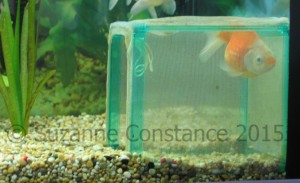
Lowering the depth of the water can sometimes help too. The water still needs to be deep enough for the fish to upend itself, and there needs to be an adequate volume of water. Shallower water can ease pressure on the swimbladder as the fish doesn’t have to work quite so hard to rise up and sink down.
There are lots of threads on various forums, videos on YouTube, and news stories about goldfish with buoyancy problems who have been given various buoyancy aids. Personally I’ve never tried this so can’t speak from experience. If you feel that something like that may help your fish, please be sure to read up about it as much as possible before trying anything. Bear in mind that a fish wasn’t designed to have something touching its scales and slimecoat all the time and keep a close eye on your fish for any signs of infection due to the slimecoat being compromised.
Make sure your fish isn’t being bullied or harassed by its tank mates. In my own experience, most of my fish have accepted a slightly weaker one and not bothered it. Young, boisterous fish may well have a pick at it though, and (as with humans!) a very few fancy goldfish aren’t very nice natured and may be inclined to bully a weaker fish.
Some fish don’t take well to disability and will fight it to the end, stressing and exhausting themselves in the process. Those that cannot sit upright and lay on their sides may also struggle to move and feed themselves. If you consider euthanasia for any fancy goldfish with buoyancy problems do make sure to get a second opinion from experienced keepers before you do anything.
In summary
- Check the water conditions
- Check the living conditions
- Check for other symptoms
- Check the diet
- Help the fish to manage problems where possible
- Euthanasia is always the last resort
Further reading
How do swimbladders work and do all fish have them? Practical Fishkeeping
Swimbladder disorder fishtanksandponds.co.uk
Goldfish buoyancy problems fishtanksandponds.co.uk
Buoyancy issues in fancy goldfish The GAB
What size tank for goldfish?
Do fish grow to the size of their tank?
Causes of ill health in fish fishtanksandponds.co.uk
Environmental problems – water problems fishtanksandponds.co.uk
A-Z of Fish Health: Part 1, A-E (Practical Fishkeeping)
A-Z of Fish Health: Part 2, F-L (Practical FIshkeeping)
A-Z of Fish Health: Part 3, M-R (Practical Fishkeeping)
A-Z of Fish Health: Part 4, S-Z (Practical Fishkeeping)
Author: Suzanne Constance
Photos courtesy of Suzanne Constance




